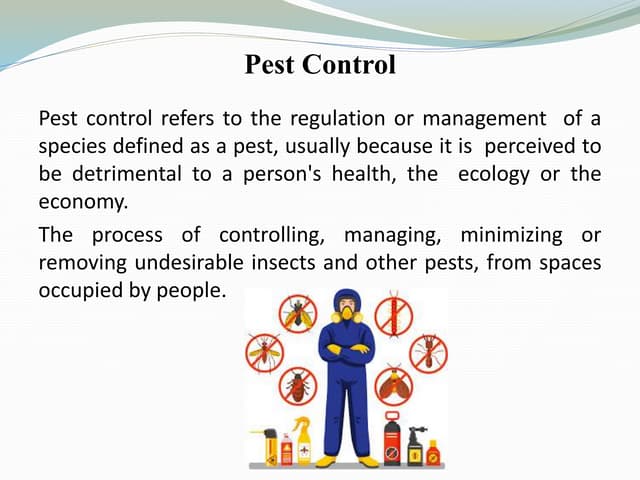5 Simple Techniques For Pestwise
5 Simple Techniques For Pestwise
Blog Article
The Of Pestwise
Table of ContentsPestwise Fundamentals ExplainedNot known Factual Statements About Pestwise Top Guidelines Of PestwiseUnknown Facts About PestwiseWhat Does Pestwise Do?See This Report about PestwiseNot known Incorrect Statements About Pestwise

Q. Define "integrated pest monitoring" (IPM) and checklist numerous feasible control strategies that may be used in an IPM strategy. A. Integrated bug administration is the combining of ideal parasite control tactics into a solitary strategy to minimize pests and their damages to an appropriate degree. Pest control tactics may include: host resistance, biological control, cultural control, mechanical control, hygiene, and chemical (chemical) control.
The Best Guide To Pestwise
What can you do to keep the insects you are attempting to regulate from becoming resistant to the chemicals you make use of? A. Pest resistance can be minimized by utilizing integrated insect management and rotating the kinds of pesticides used.
Pests are an important danger to the farming organization, and integrated insect management aids growers address and reduce these risks. Integrated parasite monitoring makes use of a number of methods in facility, thus being a more efficient service to the issue. Termite Treatment. Particularly, removing aggressive chemical approaches enables reducing damage to individuals and the environment by utilizing natural and safer options instead
Not known Facts About Pestwise
The objective of integrated parasite management is to lessen this injury and control acceptable infestation levels as opposed to get rid of all undesired populations. This is why it is very important to understand what steps are justified in each instance and usage aggressive ones just when various other incorporated management strategies do not work. Integrated management minimizes the adverse consequences of a non-IPM approach, and the primary benefits of IPM Conveniences of IPM.
A right understanding of the infestation extent figures out if the problem ought to be addressed. are the following components of an IPM program since it is essential to understand if the microorganisms make possible dangers and select the incorporated management alternatives or the specific chemical usage. intend to reduce problems by applying different agronomic strategies.
Pestwise Fundamentals Explained
Integrated monitoring choices in an IPM program begin with much safer to a lot more aggressive ones. The above-mentioned integrated administration elements help understand how to plan and implement an IPM program step by action: Display your plants on a regular basis.
To name a few, IPM social methods include the complying with field management methods: soil therapy; choice of ideal plants; crop turning; interplanting or strip chopping; option of growing days; weed control; use trap plants. Beneficial soil problems quicken plant development, and strenuous plants are more resistant to infestations. Bed Bug Treatment. In incorporated bug monitoring, dirt screening aids recognize if the area is appropriate for the manufacturing of this or that plant, and afterwards apply the lacking nutrients to guarantee plant healthy growth
Indicators on Pestwise You Need To Know
No-till techniques assistance stop soil disintegration, contributing to sustainable farming. However, when tilling is essential, it is suggested to conduct it in the autumn to expose them to all-natural opponents and severe climate. Healthy seed startings and seeds predetermine effective crop growth, so it is very important to pick pest-free planting product with strong origins.
Therefore, to name a few applications, plant rotation can be successfully used as an incorporated insect monitoring technique. Vermin spread out slower if rows of various crop types separate their host plants in intercropping or strip chopping, which is likewise made use of in the incorporated pest administration system. On the other hand, problems increase when plants of the exact same crop type or household grow together.
, as well as tomatoes. Planting trap plants in spots is one more choice for IPM intercropping. This integrated pest management technique suggests drawing in pests to specific plants and after that regulating them with chemical or mechanical techniques.
The Ultimate Guide To Pestwise
Obstacles are normal instances of physical IPM approaches. Let's take a closer consider them. Eliminating or picking parasites out manually is a time and labor-consuming option that is commonly used in integrated management and natural farming. Fully grown insects or their eggs and larvae are accumulated by hand and destroyed.

Department of Plant Sciences. This integrated management this link technique indicates an usual way of ruining parasites by predators, parasitoids, microorganisms, and various other organic control representatives (aka hostile microorganisms). The duty of organic control in IPM is to.
The 4-Minute Rule for Pestwise
With time, their population ended up being a real nuisance to farmers alongside indigenous kangaroos or dingoes. The cane toad is another case illustrating incorporated organic control failure hereof when it refused to hunt the target species and came to be a parasite itself. Parasitoids create on or within their hosts to ultimately kill them after maturing.
Report this page